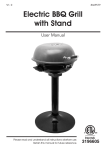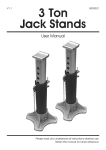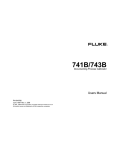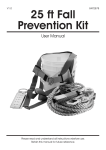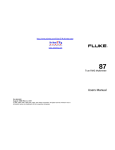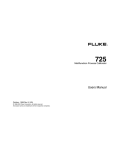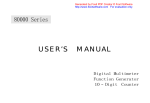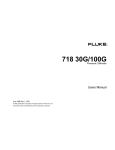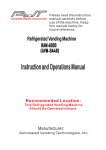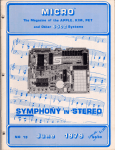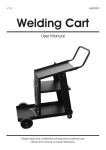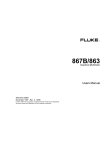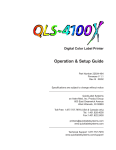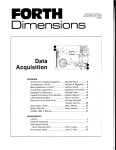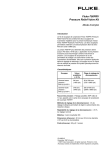Download Documenting Process Calibrator
Transcript
701/702 Documenting Process Calibrator Users Manual November 1994, Rev. 4, 3/98 © 1994, 1995, 1996, 1998 Fluke Corporation. All rights reserved. Printed in U.S.A. All product names are trademarks of their respective companies. Visit the Fluke website at: www.fluke.com ¨ Table of Contents Title Page Introduction........................................................................................................ 1 Standard Equipment ..................................................................................... 4 Safety Information ............................................................................................. 10 Getting Acquainted with Your Calibrator ........................................................... 12 Input and Output Jacks ................................................................................. 12 Keys .............................................................................................................. 14 Display .......................................................................................................... 17 Setting Up the Calibrator ................................................................................... 17 Using the Strap and Bail ............................................................................... 17 Charging the Battery ..................................................................................... 20 Battery Life .................................................................................................... 21 Automatically Saving Battery Life.................................................................. 23 Using the Optional Battery Eliminator ........................................................... 23 i 701/702 Users Manual Selecting the Display Language .................................................................... Adjusting the Display Contrast....................................................................... Setting Up the Date and Time Display........................................................... Using the Backlight ........................................................................................ Personalizing the Calibrator........................................................................... Using Measure Mode ......................................................................................... Measurement Ranges.................................................................................... Measuring Electrical Parameters ................................................................... Testing Continuity .......................................................................................... Measuring Pressure....................................................................................... Measuring Temperature ................................................................................ Using Thermocouples................................................................................ Using Resistance-Temperature Detectors (RTDs).................................... Measurements in Percent of Scale ................................................................ Damping Your Measurements ....................................................................... Using Source Mode............................................................................................ Sourcing Electrical Parameters...................................................................... Simulating a 4 to 20 mA Transmitter.............................................................. Providing Loop Power.................................................................................... Sourcing Pressure ......................................................................................... Simulating Thermocouples ............................................................................ Simulating RTDs ............................................................................................ Sourcing in Percent of Scale.......................................................................... Stepping and Ramping the Output Value ...................................................... Stepping the Output ....................................................................................... ii 24 24 24 25 26 27 27 28 30 30 33 33 36 40 40 41 41 43 45 47 50 52 54 54 54 Contents(continued) Ramping the Output ...................................................................................... Simultaneous Measure/Source ......................................................................... Calibrating a Process Instrument ...................................................................... Generating “As Found” Test Data ................................................................. Adjusting the Transmitter .............................................................................. “As Left” Test Run ......................................................................................... Memory Operations ........................................................................................... Saving Results .............................................................................................. Reviewing Memory........................................................................................ Data Logging (Model 702 Only) .................................................................... Observing Min and Max Measurements ....................................................... Viewing the Task List (Model 702 Only)........................................................ Clearing Memory........................................................................................... Quick Guide to Applications .............................................................................. Communicating with a PC (Model 702 Only)..................................................... Maintenance ...................................................................................................... Replacing the Battery Pack ........................................................................... Internal Lithium Backup Battery .................................................................... Cleaning the Calibrator ................................................................................. Calibration Data ............................................................................................ Service Center Calibration or Repair ............................................................ Replacement Parts........................................................................................ Specifications .................................................................................................... DC Voltage Measurement............................................................................. AC Voltage Measurement ............................................................................. DC Current Measurement ............................................................................. iii 55 59 62 62 66 67 68 68 69 70 72 72 73 73 83 83 83 83 83 84 84 84 86 87 88 89 701/702 Users Manual Resistance Measurement .............................................................................. Continuity Testing .......................................................................................... Frequency Measurement ............................................................................... DC Voltage Output......................................................................................... DC Current Output......................................................................................... Resistance Sourcing ...................................................................................... Frequency Sourcing....................................................................................... Temperature, Thermocouples ....................................................................... Temperature, Resistance Temperature Detectors ........................................ Loop Power Supply........................................................................................ Top and Bottom Limits of Ranges with Auto Range On ................................ General Specifications ................................................................................... Index iv 89 90 90 91 92 93 94 95 98 99 100 102 List of Tables Table 1. 2. 3. 4. 5. 6. 7. 8. 9. Title Page Summary of Source and Measure Functions......................................................... Input/Output Jacks and Connectors....................................................................... Key Functions ........................................................................................................ Battery Life............................................................................................................. Thermocouple Types Accepted ............................................................................. RTD Types Accepted............................................................................................. Simultaneous MEASURE/SOURCE Functions with Loop Power Disabled........... Simultaneous MEASURE/SOURCE Functions with Loop Power Enabled............ Replacement Parts ................................................................................................ 3 12 15 22 34 36 60 61 85 v 701/702 Users Manual vi List of Figures Figure 1. 2. 3. 4. 5. 6. 7. 8. 9. 10. 11. 12. 13. Title Standard Equipment .............................................................................................. Accessories............................................................................................................ Definition of Symbols ............................................................................................. Input/Output Jacks and Connectors....................................................................... Keys ....................................................................................................................... Elements of a Typical Display................................................................................ Installing the Strap and Using the Bail ................................................................... Removing the Battery and Using the Charger ....................................................... Electrical Measurement Connections .................................................................... Gage and Differential Pressure Modules ............................................................... Connections for Measuring Pressure..................................................................... Measuring Temperature with a Thermocouple ...................................................... Measuring Temperature with an RTD.................................................................... vii Page 5 8 10 13 14 18 19 21 29 30 32 35 39 701/702 Users Manual 14. 15. 16. 17. 18. 19. 20. 21. 22. 23. 24. 25. 26. 27. 28. 29. 30. 31. 32. 33. 34. Electrical Sourcing Connections ............................................................................. Connections for Simulating a 4 to 20 mA Transmitter ............................................ Connections for Supplying Loop Power ................................................................. Connections for Sourcing Pressure........................................................................ Connections for Simulating a Thermocouple.......................................................... Connections for Simulating an RTD ....................................................................... Checking a Relay Output Trip Alarm ...................................................................... Calibrating a Thermocouple Temperature Transmitter........................................... Calibrating a Chart Recorder.................................................................................. Measuring Voltage Drop......................................................................................... Monitoring AC Line Voltage and Frequency........................................................... Calibrating a Current-to-Pressure (I/P) Transducer................................................ Measuring the Output Current of a Transmitter...................................................... Measuring a Precision Resistor .............................................................................. Sourcing Resistance............................................................................................... Checking a Switch .................................................................................................. Checking a Tachometer ......................................................................................... Calibrating a Pressure-to-Current (P/I) Transducer................................................ Calibrating a mV to Current Transmitter................................................................. Checking a Vortex Shedding Flowmeter ................................................................ Operting Environment Specification ....................................................................... viii 42 44 46 49 51 53 58 63 74 74 75 76 77 78 78 79 79 80 81 82 103 Documenting Process Calibrator Introduction Thermocouple (TC) input/output jack that is connected to an internal isothermal block with automatic reference-junction temperature compensation. Or, you can manually enter an external temperature reference. Fluke 701 and 702 Documenting Process Calibrators (hereafter referred to as the calibrator) are batterypowered, hand-held instruments that measure and source electrical and physical parameters. See Table 1. The calibrator lets you troubleshoot, calibrate, verify, and document the calibration of process instruments. See the back of this manual for complete specifications. Stores results for later review. Logs up to 8,000 data points (Model 702 with PMLink software only.) PC interface for uploading/downloading procedures, lists, and results using PMLink software (Model 702 only). In addition to the functions in Table 1, the 701 and 702 calibrators have the following features: • General features: Automatic calibration procedures for transmitters using split screen MEASURE/SOURCE mode. Once you select the test parameters, you can select an automatic procedure or you can execute the test points one at a time. Analog display in measurement mode to make it easy to read the input level when the input is unstable. Display shows information in English, French, German, Italian, or Spanish. • Features available in MEASURE mode: 1 701/702 Users Manual Damping (smoothing of the last several readings). Display of measurements in engineering units or percent of scale. Data logging (Model 702 only). • Features available in SOURCE mode: An output ramp feature for testing limit switches. Trip detect is either a 1V change or a continuity status change (Open or Short) from one ramp increment to the next. An output step feature in which you set the step size and press uor dto step the output in engineering units or percent of scale. 2 Unless stated otherwise, everything in this manual applies to both the Fluke 701 and 702 Documenting Process Calibrators. For maintenance, repair, performance testing, and calibration instructions, order the 701/702 Service Manual (PN 944525). The phone number in the USA and Canada for replacement parts is: 1-800-526-4731. For service help in the USA and Canada call 1-800-825-9810. For application or operation assistance on Fluke products call: 800-44-FLUKE (800-443-5853) in USA and Canada (31 40) 644200 in Europe (206) 356-5500 from other countries Documenting Process Calibrator Introduction Table 1. Summary of Source and Measure Functions FUNCTION MEASURE SOURCE 0 to ±300V 0 to 11V in V or mV units (10 mA max) 0 to 300V rms, 20 Hz to 5 kHz No sourcing 1 Hz to 50 kHz, 110 mV to 300V rms 1 mV to 10V pk square wave, 2 Hz to 50 kHz 0Ω to 11 kΩ 0Ω to 11 kΩ 0 to 110 mA 0 to 22 mA (28V max) Beep and the word Short indicates No sourcing continuity t Thermocouple E, N, J, L, K, T, U, B, R, S, or C t RTD 100Ω Platinum (3926) Measure 2,3, or 4 wire. 100Ω Platinum (385) 120Ω Nickel (672) 200Ω Platinum (385) Source 2 Wire. 500Ω Platinum (385) 1000Ω Platinum (385) 10Ω Copper (427) 100Ω Platinum (3916) p Pressure 14 modules ranging from 0 to 10” H20 Note (2.5 kPa) to 0 to 10,000 psi (69,000 kPa) s Loop Power 24 or 28V (22 mA max) Note: Use an external hand pump or other pressure source as a pressure stimulus for the source pressure function. v dc V h ac V h Frequency q Resistance m dc Current q Continuity 3 701/702 Users Manual Standard Equipment The items listed below and shown in Figure 1 are included with your calibrator. If the calibrator is damaged or something is missing, contact the place of purchase immediately. To order replacement parts or spares, see the user-replaceable parts list at the end of this manual. • Model BP7217 rechargeable nickel-cadmium battery pack. • Model BC7210 battery charger. • Adjustable quick-release strap. • Jumper for three-wire RTD measurement connections (two included). • TL24 industrial test leads (two sets). • 701/702 Users Manual. • AC20 test clips (two sets). • 701/702 Quick Reference Guide. • TP20 test probes (one set). • Registration card. 4 Documenting Process Calibrator Introduction V Hz V 7 4 mA CLEAR ( ZERO) RANGE 6 2 0 V RTD 9 5 1 AC20 Test Clip TC RTD 8 3 ENTER . V mA RTD SOURCE 30V MAX MEAS 300V MAX TC TL24 Test Leads (2 Red and 2 Black) Jumper TP20 Test Probe Strap Figure 1. Standard Equipment 5 BP 72 M 6 Figure 1. Standard Equipment (cont) or Quick Reference Guide 17 AT TE RY IU B R DM LE FO TS AL CA AB UC U L - GE OD AN KE AR PR R ED SM O KE OS ER N N IC E C H U P L U IT U S IO R D IS O R A T H F IR C IT C ES RT E OR FE OP Y W RT UR ED RE AFE ONL SHO LE ED CL S OC L T MB ECY E N P R U A F IR E NO SSE US R LY TI O E RA D O IS A T B E P E R G IN G M A N T O UK O D U S R O A R IN E FL O R P.A . M F P C H IE D P O S C .S O SE IF EX U U PEC OT N S DO BC7210 Battery Charger BP7217 Nickel-Cadmium Battery Pack Cd h N i- 00 m A V 17 7. 2 Mail-in Card Users Manual Users Manual 701/702 Documenting Process Calibrator Introduction The accessories listed below and shown in Figure 2 are available from Fluke: • Pressure Modules, Fluke model numbers listed below. (Differential models also operate in gage mode.) 700P01: 0 to 10 inches of H2O, or 2.5 kPa (differential nonisolated) 700P02: 0 to 1 psi (differential, nonisolated) 700P03: 0 to 5 psi (differential, nonisolated) 700P04: 0 to 15 psi (differential, nonisolated) 700P22: 0 to 1 psi (differential, isolated) 700P23: 0 to 5 psi (differential, isolated) 700P24: 0 to 15 psi (differential, isolated) 700P05: 0 to 30 psi (gage, isolated) 700P06: 0 to 100 psi (gage, isolated) 700P07: 0 to 500 psi (gage, isolated) 700P08: 0 to 1000 psi (gage, isolated) 700P29: 0 to 3000 psi (gage, isolated) 700P30: 0 to 5000 psi (gage, isolated) 700P31: 0 to 10000 psi (gage, isolated) • Model BE9005 Series Battery Eliminator for bench-top use. • PMLink software and cable for developing procedures and transferring procedures and data (for Model 702 only). • Model BP7217 Nickel-Cadmium battery pack. • Service Kit. • C700 Carrying Case. 7 LE DU O G M I ar 06 RE 0P SU PS 7 b 70 RES 0 a P P 10 00 k 7 8 Figure 2. Accessories Fluke-700P0X Gage Pressure Module BP7217 Nickel-Cadmium Battery Pack BP 72 M 17 AT TE RY IU B R DM LE FO S CT AL CA AB U DU L - GE AN RO KE AR D R SM EP SE E R N L U K IT O N IC E C H PO U U S IO R D IS O R A T H F IR C S IT C E RT E OR FE OP Y W RT UR ED RE AFE ONL SHO LE ED CL S OC L T MB ECY E N P R U A F IR E NO SSE US R LY T IO E RA D O IS A T B E P E R G IN G M A N T O UK O D U S R O A R IN E F L O R P.A . M F P C H IE D P O S C .S O SE IF EX U U PEC OT N S DO E G AN Cd h N i- 0 0 m A V R 17 7 .2 E G R AN P M 04 RE 0P SU 70 RES 1 LE DU O /G ID bar PSPa 1 15 00 k BE9005 Battery Eliminator Fluke-700P0X Differential Pressure Module Users Manual 701/702 Documenting Process Calibrator Introduction PMLink Manual PMLink Software 3.5-Inch Floppy Disk RS-232 Cable DB9 to DB25 (9-Pin to 25-Pin) Adapter PMLink Software Figure 2. Accessories (cont) 9 701/702 Users Manual A WARNING identifies conditions and actions that pose hazards to the user; a CAUTION identifies conditions and actions that may damage the calibrator or the equipment under test. Safety Information wThis calibrator is designed and tested in accordance with IEC1010-1 and CAN/CSA C22.2 No. 1010.1-92. Use the calibrator only as specified in this manual or in the Quick Reference Guide; otherwise the protection provided by the calibrator may be impaired. Symbols used on the calibrator and in this manual are explained in Figure 3. AC-Alternating Current CAUTION see explanation in manual DC-Direct Current Common (LO) Input equipotentiality Fuse ON/OFF Pressure Equipment protected throughout by DOUBLE INSULATION or REINFORCED INSULATION Recycling CAT II Overvoltage (Installation) Category II per IEC 1010-1 refers to the level of Impluse Withstand Voltage protection provided. Typical locations include; Mains Wall outlets, local appliances and PORTABLE EQUIPMENT. Figure 3. Definition of Symbols 10 Documenting Process Calibrator Safety Information To protect yourself, follow these safety guidelines: • • • • Do not use the calibrator if it is damaged. Before you use the calibrator, inspect the insulating cover. Look for cracks or missing plastic. Pay particular attention to the insulation surrounding the connectors. Disconnect the power and discharge all highvoltage capacitors in the equipment under test before testing resistance or continuity. Inspect the test leads for damaged insulation or exposed metal. Check test lead continuity. Replace damaged test leads before using the calibrator. Do not use the calibrator if it operates abnormally. Protection may be impaired. When in doubt, have the calibrator serviced. • Select the proper function and range for your measurement. • Use caution when working above 42V pk, 30V ac rms, or 60V dc. Such voltages pose a shock hazard. • When using the probes, keep your fingers away from the probe contacts. Keep your fingers behind the finger guards on the probes. • Connect the common test lead before you connect the live test lead. When you disconnect test leads, disconnect the live test lead first. • Do not operate the calibrator around explosive gas, vapor, or dust. • When using a pressure module, make sure the process pressure line is shut off and depressurized before you connect it to the pressure module. • Disconnect test leads before changing to another measure or source function. • When servicing the calibrator, use only specified replacement parts. 11 701/702 Users Manual Getting Acquainted with Your Calibrator Input and Output Jacks Figure 4 shows the calibrator input and output jacks. Table 2 explains their use. Table 2. Input/Output Jacks and Connectors ITEM FEATURE DESCRIPTION 1 Battery Eliminator jack 2 wSERIAL PORT (702 Only) Pressure module connector TC input/output Jack for the Model BE9005 Battery Eliminator. Use the battery eliminator for benchtop applications where ac line power is available. This input does not charge the battery. The battery can only be charged in the external charger. Connects the calibrator to a personal computer. Instructions for communicating with the calibrator are in the PMLink Software manual. Connects the calibrator to a pressure module. 3 4 5, 6 w MEAS V jacks 7, 8 w SOURCE mA, MEAS mA Ω RTD jacks w SOURCE V Ω RTD jacks 9,10 12 Jack for measuring or simulating thermocouples. This jack accepts a miniature polarized thermocouple plug with flat, in-line blades spaced 7.9 mm (0.312 in) center to center. Input jacks for measuring voltage, frequency, or three- or four-wire RTDs (Resistance Temperature Detectors). Jacks for sourcing or measuring current, measuring resistance and RTDs, and supplying loop power. Output jacks for sourcing voltage, resistance, frequency, and for simulating RTDs Documenting Process Calibrator Getting Acquainted with Your Calibrator 702 DOCUMENTING PROCESS CALIBRATOR 1 2 3 MEAS SOURCE 7 9 5 1 mA CLEAR ( ZERO) RANGE 6 2 0 SETUP TC RTD 8 4 V RTD mA V Hz V 3 . ENTER 4 V mA RTD SOURCE MEAS 30V MAX 300V MAX TC 10 5 9 8 7 6 Figure 4. Input/Output Jacks and Connectors 13 701/702 Users Manual Keys Figure 5 shows the calibrator keys and Table 3 explains their functions. The softkeys are the four unmarked blue keys just below the display. Softkey functions are defined by the labels that appear above the softkey during operation. Softkey labels and other display text are shown in this manual in bold type, for example, Choices. 702 1 DOCUMENTING PROCESS CALIBRATOR 2 3 4 16 5 MEAS SOURCE 15 V 14 mA SETUP V Hz TC RTD CLEAR 7 8 9 4 5 6 1 2 3 (ZERO) 6 RANGE 7 8 9 13 0 V RTD mA . ENTER 10 V mA RTD SOURCE 300V MAX MEAS 30V MAX 12 Figure 5. Keys 14 TC 11 Documenting Process Calibrator Getting Acquainted with Your Calibrator Table 3. Key Functions ITEM FEATURE DESCRIPTION 1 M key Cycles the calibrator through MEASURE, SOURCE, and MEASURE/SOURCE modes. 2 m key Selects mA (current) measure or source function. For loop power on/off, go to the s mode. 3 s key Enters and exits the s mode to modify operating parameters. 4 Softkeys Perform the function defined by the label above each key on the display. 5 C key Turns the backlight on and off. 6 p key Selects the pressure measurement or sourcing function. 7 t key Selects TC (thermocouple) or RTD (resistance temperature detector) measurement or sourcing functions. 8 r key Toggles between autorange and locked range, and increments range. Each time you press r, the calibrator locks on the next range. Press this key again for 2 seconds to resume autorange. 9 c key Clears a partial data entry, or zeros the output when in the SOURCE mode. 10 u, d, L, R keys Adjust the display contrast. Also, use these keys to make selections when prompted. These keys also increase or decrease the output in SOURCE mode when using the step feature. 15 701/702 Users Manual Table 3. Key Functions (cont) ITEM 16 FEATURE DESCRIPTION 11 e key Terminates a numeric entry when setting a source value, or selects entries from lists. 12 q key Toggles between resistance and continuity functions in MEASURE mode, or selects the resistance function in SOURCE mode. 13 Numeric keypad Used whenever a numeric entry is required. 14 h key Toggles between ac voltage and frequency functions in MEASURE mode, or selects frequency output in SOURCE mode. 15 v key Selects the dc voltage function in MEASURE mode, or selects dc voltage in SOURCE mode. 16 o key Turns the power on and off. Documenting Process Calibrator Setting Up the Calibrator Display Setting Up the Calibrator Figure 6 shows the features of a typical display. The display shown is MEASURE mode. Near the top of the display is “Source Off.” This is the area of the display that shows what is happening in the other mode (SOURCE or MEASURE). The other parts of the display are as follows: This section consists of general information that should be read before you use the calibrator. • Status Bar: shows the time and date (if set in Setup mode), and shows the status of Loop Power, Battery Save, and Backlight Timeout; all of which are set in Setup mode. The low battery and backlight on annunciators also appear here. • Mode Indicator: Shows whether the calibrator is in MEASURE or SOURCE mode. In split screen MEASURE/SOURCE mode, there is a Mode Indicator for each window. • Measured Value: Shows the measured value in your choice of engineering units or percent of scale. • Range Status: Shows whether Auto Range is on, and what range is currently being used. Using the Strap and Bail After you unpack the calibrator, attach its carrying strap as shown in Figure 7. You can adjust the strap as necessary to hang the calibrator on any sturdy support. Figure 4 also shows you how to prop open the bail to stand the calibrator at a comfortable viewing angle for benchtop use. 17 701/702 Users Manual Loop Power Annunciator Battery Save Annunciator Status Bar Backlight Timeout Annunciator Mode Indicator Range Status Measured Value Softkey Labels Figure 6. Elements of a Typical Display 18 Documenting Process Calibrator Setting Up the Calibrator Figure 7. Installing the Strap and Using the Bail 19 701/702 Users Manual Charging the Battery wBefore you use the calibrator for the first time, charge its battery pack for 2 hours. Due to safety requirements, the battery must be charged outside the calibrator. Figure 8 shows how to remove the battery. Remove the battery door and tap the calibrator with your hand to get the battery out. Place the battery in the charger and connect the charger to line power. The charger automatically senses line voltage and adjusts itself accordingly. A discharged battery is fully charged in 2 hours or less in fast-charge mode (steady indicator light on the charger). Full charge is maintained after that time in trickle-charge mode (blinking indicator light on the charger). Switching between charging modes is automatic. You can leave the battery pack on trickle charge indefinitely without damage. 20 NOTE When you remove a charged battery from the charger, wait for the blinking indicator to go off before you insert a discharged battery. It takes about 2 seconds for the battery charger to reset. Documenting Process Calibrator Setting Up the Calibrator Battery Life BATTERY ACCESS 2 1 BATTERY ACCESS BATTERY ACCESS 3 4 Table 4 shows the operating time for a new, fully charged battery pack. Calibrator performance is guaranteed to meet specifications until the low battery annunciator blocated at the top right side of the display appears and the beeper beeps every 4 seconds. When the bannunciator appears, stop using the calibrator and charge the battery. If you have a fully charged spare battery, exchange it with the low battery. The battery is useful for up to 1,000 charge/discharge cycles. If you need to replace the battery, refer to “Replacing the Battery” later in this manual for instructions. For longest battery life and best performance, wait for bto appear before you charge the battery. Figure 8. Removing the Battery and Using the Charger 21 701/702 Users Manual Table 4. Battery Life OPERATING MODES 22 BACKLIGHT OFF BACKLIGHT ON Measure, continuous 6.5 Hours 6 Hours Measure and source, with loop power on, continuous 3.5 Hours 3 Hours Typical intermittent operation >8 Hours >8 Hours Documenting Process Calibrator Setting Up the Calibrator Automatically Saving Battery Life An optional Auto Battery Save feature turns the calibrator off after a selected idle time. The default setting for Auto Battery Save is Off. When Auto Battery Save is On, the Esymbol shows in the upper right corner of the display. The setting is preserved after you turn off the power. Auto Battery Save works the same on battery power and when using the battery eliminator. Turn on the Auto Battery Save feature as follows: 1. Press s. 2. Press d to highlight Off following Auto Battery Save. 3. Press e or the Choices softkey. 4. Press u to highlight On, then press e. 5. To accept the timeout period shown on the display, you can finish here. Press Done to exit s mode and do not go on to step 6. 6. To change the timeout period, press d to highlight the timeout period following Battery Save Timeout. 7. Press e or the Choices softkey. 8. Enter your choice of timeout period in minutes (accepted range: 1 to 120 minutes). 9. Press the Done softkey. 10. Press the Done softkey or s to exit s mode. Using the Optional Battery Eliminator CAUTION To avoid damage to the calibrator, use only Fluke Model BE9005 Series Battery Eliminator, available from your distributor. Where ac power is available, you can use the optional Fluke Model BE9005 Battery Eliminator to conserve battery power. When the battery eliminator is used, the battery is internally disconnected, and can be removed from the calibrator. The calibrator operates the same as it does under battery power, however, the specifications for the 701/702 only apply under battery operation. The battery eliminator does not charge the battery. 23 701/702 Users Manual Selecting the Display Language Setting Up the Date and Time Display The calibrator displays information in five languages. English language is the default. To change the display language, proceed as follows: The date and time are optionally displayed at the top of the display during normal operation. In s mode you can turn on or off this date and time display. You can also control the format used to display the date and time. You should set the calendar and clock whether or not you use the date and time display, since a timestamp is applied to all saved results. Proceed as follows to set up the time and date displays: 1. Press s. 2. Press the third softkey from the left twice. 3. Press dthree times. 4. Press e. 5. Press uor d to highlight your choice of language. 6. Press e to confirm your choice. The language you choose is the power-up default. 7. Press s to exit s mode. Adjusting the Display Contrast Press u or R to increase contrast. Press L or dto decrease contrast. When the u and d keys are being used to select an item from a list, for example in s mode, use the L and R keys. 24 1. Press s. 2. Press the Next Page softkey. The display appears as follows: Documenting Process Calibrator Setting Up the Calibrator 3. Use the u and dkeys to move the cursor to the parameter you want to change, then press e or the Choices softkey to choose a setting for that parameter. For example, the following display appears after you select Date Format: 4. Press uor d to move the cursor to the desired date format. 5. Press e to go back to the s display. 6. Make another selection or press the Done softkey or s to save your settings and exit s mode. Using the Backlight Press C to turn on the display backlight. Press C again to turn it off. When the backlight is on, the G symbol shows at the top of the display. If desired, you can minimize battery usage by setting the calibrator to turn the display backlight off automatically. When the backlight is turned on and 25 701/702 Users Manual Auto Backlight Off is activated, the asymbol shows at the top of the display. To automatically turn off the backlight after a set time, proceed as follows: 1. Press s. 2. Press d to highlight Off following Auto Backlight Off. 3. Press e or the Choices softkey. 4. Press u to highlight On, then press e. 5. To accept the timeout period shown on the display, you can finish here. Press Done to exit s mode and do not go on to step 6. 6. To change the timeout period, press d to highlight the timeout period following Backlight Timeout. 7. Press e or the Choices softkey. 8. Enter your choice of timeout period in minutes (accepted range: 1 to 120 minutes). 9. Press the Done softkey. 26 10. Press the Done softkey or s to exit s mode. Personalizing the Calibrator You can load your name or some another alphanumeric identifier into the calibrator for display at power-up and in saved results. Proceed as follows to load an identifier: 1. Press s 2. Press Next Page twice. 3. Press d to move the cursor to the same line as ID. 4. Press e or the Choices softkey. The display appears as follows: Documenting Process Calibrator Using Measure Mode Using Measure Mode NOTE To achieve best measurement noise and accuracy performance, do not use the battery eliminator, and tie all three common jacks together. 5. The ID string is shown at the bottom of the boxed area. To erase a character, press the Back Space softkey. To erase the whole string, press c. 6. Press u, d, L, or R to select a character, then press e. Use the numeric keypad if you want to enter a number. 7. Repeat step 6 until you are satisfied with the ID string appearing in the window. 8. Press the Done softkey. 9. Press the Done softkey or s to exit s mode. The operating mode (i.e., MEASURE, SOURCE) is shown in a reverse-video bar on the display. If the calibrator is not in MEASURE mode, press M until MEASURE is shown. You must be in MEASURE mode to change any of the MEASURE parameters. Measurement Ranges The calibrator normally changes to the appropriate measurement range automatically. The lower right side of the display shows either “Range” or “Auto Range” depending on the range status. Auto Range switch points are shown in the Specifications at the end of this manual. When you press the R key, the range is locked. Press it again to cycle to and lock on the next higher range. Press it and hold it for two seconds to revert to Auto Range. 27 701/702 Users Manual If the range is locked, overrange inputs produce a display of - - - - - -. In Auto Range, out of range inputs produce a display of ! ! ! ! ! !. Measuring Electrical Parameters When you turn on the calibrator, it powers up in the dc voltage measurement function. To select an electrical measurement function from either SOURCE or MEASURE/SOURCE mode, first press M for MEASURE mode, then proceed as follows: 1. Press M for current, v for dc voltage, h once for ac voltage or twice for frequency, or q for resistance. 28 NOTE To measure frequency you are prompted to select a frequency range as shown next. If you expect the frequency you are measuring to be below 20 Hz, press d to select the lower frequency range, then press e. 2. Connect the test leads as shown in Figure 9, depending on the measurement function. Documenting Process Calibrator Using Measure Mode Red V RTD mA mA SOURCE MEAS 30V MAX + V RTD 300V MAX TC – Black Red V RTD mA mA V RTD SOURCE 30V MAX MEAS 300V MAX TC Black Figure 9. Electrical Measurement Connections 29 701/702 Users Manual Testing Continuity In the continuity function, the beeper sounds and the word Short appears on the display when the resistance between the Ω MEAS jack and its common jack is less than 10Ω. The word Open appears when the resistance is greater than 400Ω. Proceed as follows to test continuity: 1. Remove power from the circuit to be tested. 2. If necessary, press M for MEASURE mode. 3. Press q twice so that Open appears. measure the difference between the applied pressure on the high fitting versus the low fitting. Figure 10 shows the two types. Proceed as follows to measure pressure: W WARNING TO AVOID A VIOLENT RELEASE OF PRESSURE IN A PRESSURIZED SYSTEM, SHUT OFF THE VALVE AND SLOWLY BLEED OFF THE PRESSURE BEFORE YOU ATTACH THE PRESSURE MODULE TO THE PRESSURE LINE. 4. Connect the calibrator to the circuit to be tested as Figure 9 shows. Gage Measuring Pressure 700P06 To measure pressure, attach the appropriate pressure module for the pressure to be tested. Pressure modules are available in gage or differential types depending on range. (See “ACCESSORIES” near the front of this manual.)Gage pressure modules have one pressure fitting and measure the process pressure with respect to atmospheric pressure. Differential pressure modules have two pressure fittings and 30 Differential Low PRESSURE MODULE RANGE 100 PSIG 700 kPa 7 bar BURST PRESSURE 300 PSIG High 700P04 PRESSURE MODULE RANGE 15 PSID/G 100 kPa 1 bar BURST PRESSURE 45 PSIG Figure 10. Gage and Differential Pressure Modules Documenting Process Calibrator Using Measure Mode CAUTION To avoid mechanically damaging the pressure module, never apply more than 10 ft.-lbs. of torque between the pressure module fittings or between the fittings and the body of the module. Always apply appropriate torque between the pressure module fitting and connecting fittings or adapters. To avoid damaging the pressure module from overpressure, never apply pressure above the rated maximum printed on the pressure module. To avoid damaging the pressure module from corrosion, use them only with specified materials. Refer to the pressure module instruction sheet for the specified material compatibility for your pressure module. 1. Connect a pressure module to the calibrator as shown in Figure 11. The threads on the pressure modules accept standard ¼ NPT pipe fittings. Use the supplied ¼ NPT to ¼ ISO adapter if necessary. 2. Press M for MEASURE mode. 3. Press p. The calibrator automatically senses which pressure module is attached and sets its range accordingly. 4. To zero the pressure module, vent the module to atmosphere, and press c. Repeat this step until the reading is zeroed. You must perform this step before you execute a PMLink Task that measures pressure. 5. If necessary, you can change pressure display units to psi, mmHg, inHg, inH2O, ftH2O, bar, or kPa as follows: a. Press s b. Press Next Page twice. c. Press e or the Choices softkey with the cursor on Pressure Units. d. Select the pressure units with the u or d keys. e. Press e. f. Press the Done softkey. 31 701/702 Users Manual 702 Isolation Valve DOCUMENTING PROCESS CALIBRATOR Gage Module MEAS SOURCE 7 9 5 1 mA CLEAR ( ZERO) RANGE 6 2 0 SETUP TC RTD 8 4 V RTD mA V Hz V 3 ENTER . V mA RTD SOURCE 30V MAX MEAS 300V MAX TC Differential Module L H Tank Figure 11. Connections for Measuring Pressure 32 Documenting Process Calibrator Using Measure Mode Measuring Temperature Using Thermocouples The calibrator supports eleven standard thermocouples, each identified with an alpha character: C, L, U, E, N, J, K, T, B, R, or S. Table 5 summarizes the ranges and characteristics of the supported thermocouples. To measure temperature using a thermocouple, proceed as follows: 1. Attach the thermocouple leads to the appropriate TC miniplug, then to the TC jack as shown in Figure 12. One pin is wider than the other. Do not try to force a miniplug in the wrong polarization. NOTE If the calibrator and the thermocouple plug are at different temperatures, wait one minute or more for the connector temperature to stabilize after you plug the connector into the TC jack. 2. If necessary, press M for MEASURE mode. 3. Press tso that the display prompting you to select the TC type shows. 4. Select the desired TC type using the u or d followed by e. 5. If necessary, you can change between °C or °F Temperature Units in s mode as follows: a. Press s b. Press the Next Page softkey twice. c. Use the u and d keys to move the cursor to the parameter you which to change, then press e or the Choices softkey to choose a setting for that parameter. d. Press u or d to move the cursor to the desired setting. e. Press e to go back to the s display. f. Press the Done softkey or s to exit s mode. 6. If necessary, you can change between ITS-90 or IPTS-68 Temperature Scale in s mode. The procedure is the same as steps a through f above. 33 701/702 Users Manual Table 5. Thermocouple Types Accepted TYPE POSITIVE LEAD MATERIAL POSITIVE LEAD (H) COLOR ANSI* E Chromel Purple N Ni-Cr-Si Orange J Iron White K Chromel T IEC** Violet NEGATIVE LEAD MATERIAL SPECIFIED RANGE (°C) Constantan -250 to 1000 Ni-Si-Mg -270 to 1300 Black Constantan -210 to 1200 Yellow Green Alumel -270 to 1372 Copper Blue Brown Constantan -250 to 400 B Platinum (30% Rhodium) Gray Platinum (6% Rhodium) 600 to 1820 R Platinum (13% Rhodium) Black Orange Platinum -20 to 1767 S Platinum (10% Rhodium) Black Orange Platinum -20 to 1767 C *** Tungsten (5% Rhenium) White Tungsten (26% Rhenium) 0 to 2316 L (DIN J) Iron Constantan -200 to 900 U (DIN T) Copper Constantan -200 to 600 *American National Standards Institute (ANSI) device negative lead (L) is always red. **International Electrotechnical Commission (IEC) device negative lead (L) is always white. *** Not an ANSI designation but a Hoskins Engineering Company designation. 34 Documenting Process Calibrator Using Measure Mode V RTD mA mA V RTD SOURCE 30V MAX MEAS 300V MAX Process Temperature TC TC Minijack Figure 12. Measuring Temperature with a Thermocouple 35 701/702 Users Manual Using Resistance-Temperature Detectors (RTDs) The calibrator accepts RTD types shown in Table 6. RTDs are characterized by their resistance at 0°C (32°F), which is called the “ice point” or R0. The most common R0 is 100Ω. Most RTDs come in a threeterminal configuration. The calibrator accepts RTD measurement inputs in two-, three-, or four-wire connections. A four-wire configuration provides the highest measurement precision, and two-wire provides the lowest measurement precision. Table 6. RTD Types Accepted RTD TYPE ICE POINT (R ) 0 MATERIAL α RANGE (°C) Pt100 (3926) 100Ω Platinum 0.003926Ω/°C -200 to 630 *Pt100 (385) 100Ω Platinum 0.00385Ω/°C -200 to 800 Ni120 120Ω Nickel 0.00672Ω/°C -80 to 260 Pt100 (3916) 100Ω Platinum 0.003916Ω/°C -200 to 630 Pt200 (385) 200Ω Platinum 0.00385Ω/°C -200 to 630 Pt500 (385) 500Ω Platinum 0.00385Ω/°C -200 to 630 Pt1000 (385) 1000Ω Platinum 0.00385Ω/°C -200 to 630 Cu 10 (427) 9.035Ω ** Copper 0.00427Ω/°C -100 to 260 *Per IEC 751-Standard 36 **10Ω @ 25°C Documenting Process Calibrator Using Measure Mode To measure temperature using an RTD input, proceed as follows: 1. If necessary, press M for MEASURE mode. 2. Press ttwice so that Select RTD Type shows. 3. Press u or d to select the desired RTD type. CAUTION Do not force a dual banana plug between any two jacks in the horizontal orientation. (See the Figure.) Doing so will damage the jacks. Use the supplied jumper wire when needed for RTD measurements. You can use a dual banana plug in the vertical orientation. 4. Press e. 5. Press u or d to select a 2-, 3-, or 4- wire connection. 6. Attach the RTD to input jacks as the display or Figure 13 shows. Use the supplied jumper between the mA Ω RTD MEAS low jack and the V MEAS low jack as shown if you are using a 3wire connection. 7. Press e. 37 701/702 Users Manual c. V RTD mA mA V RTD SOURCE MEAS 30V MAX 300V MAX WRONG TC Use the u and d keys to move the cursor to the parameter you which to change, then press e or the Choices softkey to choose a setting for that parameter. d. Press u or d to move the cursor to the desired setting. e. Press e to go back to the s display. f. V RTD V RTD mA mA mA mA SOURCE 30V MAX SOURCE 30V MAX MEAS 300V MAX V RTD V RTD MEAS 300V MAX TC TC OK 8. If necessary, you can change between °C or°F Temperature Units in s mode as follows: a. Press s b. Press the Next Page softkey twice. 38 Press the Done softkey or s to exit s mode. 9. If necessary, you can change between ITS-90 or IPTS-68 Temperature Scale in s mode. The procedure is the same as steps a through f above. Documenting Process Calibrator Using Measure Mode V RTD mA mA V RTD RTD SOURCE MEAS 30V MAX V RTD mA mA 300V MAX TC RTD V RTD SOURCE MEAS 30V MAX V RTD mA mA 300V MAX TC RTD V RTD SOURCE 30V MAX MEAS 300V MAX TC Figure 13. Measuring Temperature with an RTD 39 701/702 Users Manual Measurements in Percent of Scale 6. Use the numeric keypad to enter the 100% of scale value. To display measurements as a percent of scale as shown below, proceed as follows: 7. Press e. 8. Press the Done softkey. Percent of scale remains in effect until you press the Scale softkey again or change to another measurement function. Damping Your Measurements 1. If necessary, press M for MEASURE mode. 2. Select a measurement function (m, v, q, t, or p) as previously described. 3. Press the Scale softkey. 4. Use the numeric keypad to enter the 0% of scale value. 5. Press e. 40 The calibrator normally applies a software filter to dampen measurements in all functions except continuity. The specifications assume that damping is turned on. The damping method is a running average of the last several measurements. Fluke recommends that you leave damping on. Turning damping off may be useful when measurement response is more important than accuracy or noise reduction. If you want to turn off damping, press the More Choices softkey twice, then press the Dampen softkey so that Off appears. Press Dampen again to turn damping back on. The default state is On. Documenting Process Calibrator Using Source Mode NOTE If a measurement falls outside a random noise window, a new average is started. If damping is turned off, or until measurements are fully damped, the g symbol is displayed. Using Source Mode The operating mode (i.e., MEASURE, SOURCE) is shown in a reverse-video bar on the display. If the calibrator is not in SOURCE mode, press M until SOURCE is shown. You must be in SOURCE mode to change any of the SOURCE parameters. Sourcing Electrical Parameters To select an electrical sourcing function, proceed as follows: 1. Connect the test leads as shown in Figure 14, depending on the source function. 2. Press M for current, v for dc voltage, h for frequency, or q for resistance. 3. Enter the desired output value, then press e. For example, to source 5.0V dc, press v 5 . 0 e. 4. To change the output value enter a new value and press e. NOTE If you are sourcing current, wait for the g symbol to go out before you use the output. 5. To set the output value to 0 in the present source function, press c. 6. To turn off sourcing completely, press c twice. NOTE Use the source current function to drive a current loop. This is different than the loop power function in which the calibrator is powering a process instrument. To source loop power, use the Loop Power function accessible from s mode. 41 701/702 Users Manual Red V RTD mA mA V RTD + SOURCE MEAS 30V MAX 300V MAX TC – Black Common Red + V RTD mA mA V RTD SOURCE 30V MAX MEAS 300V MAX – Black Common Figure 14. Electrical Sourcing Connections 42 TC Documenting Process Calibrator Using Source Mode Simulating a 4 to 20 mA Transmitter You can configure the calibrator as a load on a current loop through the SOURCE mA function. When you press the M key in SOURCE mode, the display prompts you to select Source mA or Simulate Transmitter. The difference in operation is that when you Source mA the calibrator is sourcing current, and when you Simulate Transmitter the calibrator is sourcing a variable resistance to regulate current to the specified value. Connect an external loop supply to the positive (top) mA jack as shown in Figure 15. 43 701/702 Users Manual 701 DOCUMENTING PROCESS CALIBRATOR MEAS SOURCE Red + +24 Loop Power Supply SETUP TC RTD 7 8 9 CLEAR 4 5 6 2 3 0 . 1 V RTD mA V Hz V mA ( ZERO) RANGE ENTER mA V RTD SOURCE 30V MAX MEAS 300V MAX TC Black UUT – Figure 15. Connections for Simulating a 4 to 20 mA Transmitter 44 Documenting Process Calibrator Using Source Mode Providing Loop Power The calibrator provides loop power at 28V or 24V dc. The 28V setting provides enough current for two or three 4-20 mA devices on the loop in addition to the two-wire transmitter but uses more battery power. Use the 24V setting if there are two or fewer loads on the loop in addition to the two-wire transmitter. (Each device on a typical 4- to 20-mA loop has a resistance of 250Ω, thus dropping 5V at 20 mA. A typical transmitter must have 11V minimum in order to operate correctly at its top end.) 2. Note that following Loop Power, Disabled is highlighted. Press e. 3. Use the u or d arrow keys to select Enabled 24V or Enabled 28V. 4. Press e. 5. Press the Done softkey. When loop power is enabled, the mA (middle column) jacks are dedicated to sourcing and measuring the current loop. This means that the SOURCE mA, measure RTD, and measure and source Ω functions are not available (see Table 8, later in this manual.) Connect the calibrator in series with the instrument current loop as Figure 16 shows. Proceed as follows to source loop power: 1. Press s for s mode. 45 701/702 Users Manual 701 DOCUMENTING PROCESS CALIBRATOR MEAS SOURCE mA SETUP V Hz TC RTD 7 8 9 CLEAR 4 5 6 2 3 0 . V 1 ( ZERO) TEST DC PWR – ++ – RANGE ENTER Red + V RTD mA mA – V RTD SOURCE 30V MAX MEAS 300V MAX TC Black Figure 16. Connections for Supplying Loop Power 46 Documenting Process Calibrator Using Source Mode Sourcing Pressure The calibrator provides a source pressure display function that requires the use of an external pressure hand pump. Use this function to calibrate instruments that require a pressure source or differential pressure measurement. See Figure 31 for information about that application. Pressure modules are available in gage or differential types, depending on range. (See “Accessories” near the front of this manual.) Gage pressure modules have one pressure fitting and measure the process pressure with respect to atmospheric pressure. Differential pressure modules have two pressure fittings and measure the difference between the pressure applied to the high fitting and the pressure applied to the low fitting. If the low fitting is left open, the pressure module acts as a gage unit. To use the source pressure display, see Figure 17 and proceed as follows: W WARNING TO AVOID A VIOLENT RELEASE OF PRESSURE IN A PRESSURIZED SYSTEM, SHUT OFF THE VALVE AND SLOWLY BLEED OFF THE PRESSURE BEFORE YOU ATTACH THE PRESSURE MODULE TO THE PRESSURE LINE. CAUTION To avoid mechanically damaging the pressure module, never apply more than 10 ft.-lbs. of torque between the pressure module fittings or between the fittings and the body of the module. Always apply appropriate torque between the pressure module fitting and connecting fittings or adapters. To avoid damaging the pressure module from overpressure, never apply pressure above the rated maximum printed on the pressure module. 47 701/702 Users Manual To avoid damaging the pressure module from corrosion, use them only with specified materials. Refer to the pressure module instruction sheet for the specified material compatibility for your pressure module. 1. Connect a pressure module and pressure source to the calibrator as Figure 17 shows. The threads on the pressure modules accept ¼ NPT fittings. Use the supplied ¼ NPT to ¼ ISO adapter if necessary. 2. If necessary, press M for SOURCE mode. 3. Press p. The calibrator automatically senses which pressure module is attached and sets its range accordingly. 4. To zero the pressure module, vent the module to atmosphere, and press c. Repeat this step until the reading is zeroed. You must perform this step before you execute a PMLink Task that sources pressure 48 5. Pressurize the pressure line with the pressure source to the desired level as shown on the display. 6. If necessary, you can change pressure display units to psi, mmHg, inHg, inH2O, ftH2O, bar, or kPa as follows: a. Press s b. Press Next Page twice. c. Press e with the cursor on Pressure Units. d. Select the pressure units with the u or d keys. e. Press e. f. Press the Done softkey. Documenting Process Calibrator Using Source Mode Pressure Module 701 DOCUMENTING PROCESS CALIBRATOR Hand Pump MEAS SOURCE 8 9 4 5 6 2 3 0 . mA SETUP TC RTD 7 1 V RTD mA V Hz V CLEAR ( ZERO) RANGE ENTER mA V RTD SOURCE 30V MAX MEAS 300V MAX TC Figure 17. Connections for Sourcing Pressure 49 701/702 Users Manual Simulating Thermocouples NOTE Refer to “Measuring Temperature” earlier in the manual for a table of data relating to thermocouple types supported by the calibrator. Connect the calibrator TC connector to the instrument under test with thermocouple wireand theappropriate thermocouple mini-connector (polarized thermocouple plug with flat, in-line blades spaced 7.9 mm (0.312 in) center to center). One pin is wider than the other. Do not try to force a miniplug in the wrong polarization. Figure 18 shows this connection. Proceed as follows to simulate a thermocouple: 1. Attach the thermocouple leads to the appropriate TC miniplug, then to the TC jack as Figure 12 shows. 2. If necessary, press M for SOURCE mode. 50 3. Press tfor the display that prompts you to enter thermocouple type. 4. Press the u or d key followed by e to select the desired thermocouple type. 5. Enter the temperature you want to simulate as prompted by the display and press e. NOTE If you use copper wire instead of thermocouple wire, the reference junction is no longer inside the calibrator. The reference junction is moved to the instrument (transmitter, indicator, controller, etc.) input terminals. You must measure this external reference temperature accurately and enter it into the calibrator. Do this by pressing s and setting Ref. Junc. Compensat and Ref. Junc. Temp. After you enter the external reference temperature, the calibrator corrects all voltages to compensate for this new reference junction temperature. Documenting Process Calibrator Using Source Mode 701 DOCUMENTING PROCESS CALIBRATOR Color depends on type of TC TEST DC PWR – ++ + MEAS SOURCE V Hz V 8 9 4 5 6 2 3 0 . mA – SETUP TC RTD 7 1 V RTD mA CLEAR ( ZERO) RANGE ENTER mA V RTD SOURCE 30V MAX MEAS 300V MAX TC TC Minijack Figure 18. Connections for Simulating a Thermocouple 51 701/702 Users Manual 1. If necessary, press M for SOURCE mode. Simulating RTDs NOTE Refer to Table 6 for information about RTD (Resistance Temperature Detector) types supported by the calibrator. Connect the calibrator to the instrument under test as shown in Figure 19. Proceed as follows to simulate an RTD (Resistance Temperature Detector): 52 2. Press tuntil the select RTD type display is showing. 3. Press the u or d keys followed by e to select the desired RTD type. 4. Enter the temperature you want to simulate as prompted by the display, then press e. Documenting Process Calibrator Using Source Mode RTD Transmitter Black V RTD mA mA V RTD SOURCE 30V MAX MEAS 300V MAX TC -PS +PS M -IN +IN S Z Red Figure 19. Connections for Simulating an RTD 53 701/702 Users Manual Sourcing in Percent of Scale 6. Use the numeric keypad to enter the 100% of scale value. To adjust the source value as a percent of scale as shown below, proceed as follows: 7. Press e. 8. Press the Done softkey. Percent of scale remains in effect until you press the Scale softkey again. Stepping and Ramping the Output Value Two special features are available for adjusting the value of source functions except pressure (sourcing pressure requires that you use an external pressure source): 1. If necessary, press M for SOURCE mode. 2. Select a source function (m, v, q, t, or p) as previously described. 3. Press the Scale softkey. 4. Use the numeric keypad to enter the 0% of scale value. 5. Press e. 54 • Stepping the output with the u and d keys. • Ramping the output with optional continuity or V trip detect. Stepping the Output The step feature allows you to select a step size in engineering units (mV, V, mA, °C, etc.) or % of scale. Stepping the output in % of scale is useful for quickly jumping between 0% and 100% (set step size = 100%) or 0-50-100% (set step size = 50%). Stepping Documenting Process Calibrator Using Source Mode works in SOURCE and in MEASURE/SOURCE modes. Proceed as follows to select a step size: 1. Refer to the appropriate heading earlier in this manual (e.g., “Sourcing Electrical Parameters”) and connect the calibrator to the circuit to be tested. 2. If necessary, press M for SOURCE mode. 3. Set the calibrator for the desired source value. 4. If you want to step the source value in % of scale, set the % of scale value as described previously under “Sourcing in Percent of Scale.” 5. Press the More Choices softkey. 6. Press the Step Size softkey. 7. Use the numeric keypad to enter the step size in the units shown on the display. 8. Press the Done softkey. 9. Now you can adjust the output in steps by pressing the u and d keys. Ramping the Output Ramping is sweeping the source up or down in value. Use the ramp feature to check a limit switch or alarm, or any time you want a smoothly increasing or decreasing output function. You can set the calibrator to ramp up or down in engineering units (mV, V, mA,°C, etc.) or % of scale. During ramping, the output is adjusted 4 times per second. The size of the steps is determined by your choices of endpoints and ramp time. For example, if you set the calibrator to ramp from 10 mV to 1V over 10 seconds, the output is adjusted in approximately 25 mV steps. Ramping continues until the selected limit is reached, or until an optional trip condition is encountered. The optional trip detect works as follows: during ramping, the calibrator checks for either a 1V change in dc voltage or a change in continuity status (Open or Short) from one ¼ second interval to the next. Proceed as follows to ramp (i.e., sweep the source): 1. Refer to the appropriate heading earlier in this manual (e.g., “Sourcing Electrical Parameters”) 55 701/702 Users Manual and connect the calibrator to the circuit to be tested. Figure 20 shows an example. 2. If you want to automatically stop ramping if a trip condition is detected, connect a voltage trip circuit to the V MEAS jacks or a continuity trip circuit to the mA Ω RTD MEAS jacks. (Continuity detection is not available when sourcing current.) 3. If necessary, press M for SOURCE mode. 4. Set the calibrator for the desired source value as previously described. 5. If you want to ramp the output in % of scale, set % of scale as described previously under “Sourcing in Percent of Scale.” 6. Press the More Choices softkey. 56 7. Press the Ramp softkey. The display changes to the following: Documenting Process Calibrator Using Source Mode 8. Fill in the parameters as prompted. Enter the Start Value, End Value, and Ramp Time. 11. Select a low-to-high ramp or a high-to-low ramp with the Ramp Up/Down softkey. 9. If you want to automatically stop ramping if a trip condition is detected, set the Trip Detect to Enabled, and select Voltage or Continuity as the trip function. 12. To start ramping, press the Start Ramp softkey. 13. Ramping continues until a trip is detected (if enabled), the ramp time expires, or you press the Stop Ramp softkey. 10. Press the Done softkey. Note the RAMP annunciator next to SOURCE at the top of the display. 57 701/702 Users Manual 701 DOCUMENTING PROCESS CALIBRATOR Trip Relay Output Voltage Trip Detect – + Red MEAS SOURCE 8 9 4 5 6 2 3 0 . mA SETUP TC RTD 7 1 V RTD mA V Hz V CLEAR ( ZERO) RANGE Input 4 – 20 mA ENTER mA + V RTD SOURCE 30V MAX MEAS 300V MAX – Black TC Red Source mA Figure 20. Checking a Relay Output Trip Alarm 58 Black Documenting Process Calibrator Simultaneous Measure/Source Simultaneous Measure/Source Use MEASURE/SOURCE mode to calibrate process instruments. Press M so that the split screen display appears (see below). Table 7 shows the functions you can use simultaneously when Loop Power is disabled. Table 8 shows the functions you can use simultaneously when Loop Power is enabled. You can use the step feature to adjust the output in MEASURE/SOURCE mode or you can use the calibration routine provided when you press the As Found softkey. 59 701/702 Users Manual Table 7. Simultaneous MEASURE/SOURCE Functions with Loop Power Disabled SOURCE FUNCTION MEASURE FUNCTION dc V mA Freq Ω TC 2W RTD Pressure dc V • • • • • • • mA • • • • • • ac V • • • • • • • Frequency (≥20 Hz) • • • • • • • Low Frequency (<20 Hz) 60 Ω • • • • • • Continuity • • • • • • TC • • • • • 2W RTD • • • • • • 3W RTD • • • • • • 4W RTD • • • • • • Pressure • • • • • • • Documenting Process Calibrator Simultaneous Measure/Source Table 8. Simultaneous MEASURE/SOURCE Functions with Loop Power Enabled SOURCE FUNCTION MEASURE FUNCTION dc V mA Freq Ω TC 2W RTD Pressure dc V • • • • • • mA • • • • • • ac V • • • • • • Frequency (≥20 Hz) • • • • • • TC • • • • • Pressure • • • The two softkeys displayed in MEASURE/SOURCE mode are for use in calibrating a process instrument. Instructions for calibrating a process instrument are provided next. • • • As Found, which starts up a calibration routine to obtain and record as found data. • Adjust, for making adjustments to a transmitter if required. 61 701/702 Users Manual Calibrating a Process Instrument When the calibrator is in simultaneous MEASURE/SOURCE mode, a built-in calibration routine is activated when you press the As Found softkey. (As Found data are the test results showing the condition of a transmitter before it is calibrated.) Additionally, Model 702 runs procedures developed using PMLink software. To use procedures from PMLink software, see the PMLink manual. Generating “As Found” Test Data The following example shows how to generate as found data for a thermocouple temperature transmitter. In this case the calibrator is simulating the output of a thermocouple and measuring the resulting current from the transmitter. Other transmitters use this same method. Just go back to MEASUREMENT or SOURCE mode and change the operating parameters before you press As Found. 1. Connect the test leads to the instrument under test as shown in Figure 21. The connections simulate a thermocouple and measure the corresponding output current. 62 2. If necessary, press M for MEASURE mode. 3. Press M. 4. Press M for SOURCE mode. 5. Press t. 6. Use the u and d keys to select the thermocouple type, then press e. 7. Enter a source value, for example 100°, then e. 8. Press M for MEASURE/SOURCE mode. The display changes as follows: Documenting Process Calibrator Calibrating a Process Instrument 701 DOCUMENTING PROCESS CALIBRATOR Color depends on type of TC MEAS SOURCE 7 8 9 5 6 2 3 0 . mA + SETUP CLEAR ( ZERO) 30V MAX – RANGE Original Circuit Wiring ENTER mA V RTD SOURCE – ++ TC RTD 4 1 V RTD mA V Hz V TEST DC PWR MEAS Red 300V MAX TC Minijack – Power Supply + Black Figure 21. Calibrating a Thermocouple Temperature Transmitter 63 701/702 Users Manual 9. Press the As Found softkey. The display changes as follows: NOTE If you set User-Entered Value to Enabled, you will be prompted to enter a value at each test point in the measured units. Errors will be calculated and displayed based on the user-entered value, not the measured value. 11. Use the arrow keys to move the cursor down to enter 0% and 100% values for SOURCE temperature. Our example uses 100°C and 300°C. 10. Enter values for 0% and 100% of 4.0 mA and 20.0 mA, respectively. Set Tolerance to 0.5% of span. (Use other values if necessary for your application.) User Entered Value is for a value measured by some other device, such as the reading reported by the control room. Leave this set to Disabled because you are only interested in values measured at the transmitter output. 64 12. The Test Strategy is the number of test points and which test points are performed rising and falling in percent of scale. Our example uses five points (0%, 25%, 50%, 75%, and 100%), rising only. Rising is indicated by the up arrow on the display. Change to another test strategy by pressing e on this line. A list of strategies appears from which to choose. Select one, then press Done. When you finish selecting the calibration parameters, the display appears as follows: Documenting Process Calibrator Calibrating a Process Instrument 13. Press the Done softkey to accept the calibration parameters. The display changes as follows: 14. You now have the choice of starting an automatic test or stepping through the test points manually. Press the Auto Test softkey to have the calibrator run through the tests automatically. (Abort gets you out of the calibration procedure.) The tests begin at the zero point, sourcing the correct temperature (a voltage) and measuring the corresponding current from the transmitter. As soon as a measurement has settled and has been captured, the calibrator moves on to the next step. Because the calibrator waits for the measurement to stop changing, the Auto Test works correctly for instruments with built-in damping.The error of the expected measured 65 701/702 Users Manual value is shown in the top left of the measure window. failures were outside the ±0.5% tolerance that we selected. 15. The calibrator moves on to the remaining set of points. For temperature and electrical parameter calibration, the points are done automatically. If you are sourcing pressure, the calibrator pauses at each step for you to adjust the pressure source. When the tests are complete, an error summary table, such as the following is displayed. 17. Either press the Done softkey to save the data, or the Abort softkey to delete the data and start over. You have to go back to As Found to restart the calibration. You can see the saved data entry and recall the table for later viewing through the Review Memory softkey during normal operation. With Model 702 you can upload this data to a PC using PMLink software. See the PMLink Manual for instructions. Adjusting the Transmitter Proceed as follows to make the calibration adjustments to the transmitter. (Always refer to the transmitter manufacturer’s instructions to locate the adjustment controls and connection points for your transmitter). 1. Press the Done softkey while viewing the results summary. 16. In the results summary test, failures are highlighted. An adjustment is required in this example because three tests show failures. The 66 2. Press the Adjust softkey. The calibrator sources 0% of span (100°C in this example) and displays the following softkeys: Documenting Process Calibrator Calibrating a Process Instrument • • • • Go to 100%/Go to 0% Go to 50% As Left Exit Cal 3. Adjust the transmitter output for 4 mA then press the Go to 100% softkey. 2. Press the Auto Test softkey to begin an automatic sequence through all the test points, or you can step through the tests manually. 3. When the tests are complete, observe the error summary table, such as the following. 4. Adjust the transmitter output for 20 mA. 5. If the span was adjusted in step 4, you must go back and repeat steps 3 and 4 until no more adjustment is required. 6. Now check the transmitter at 50%. If it is within specification, your adjustment is complete. If not, adjust the linearity and begin this procedure again at step 3. “As Left” Test Run Proceed as follows to generate and record as left data for the thermocouple temperature transmitter you have just adjusted. 1. Press the As Left softkey to record as left data. An asterisk (*) next to a measure or source value indicates an unsettled value (g annunciator) when the measurement was taken. 4. If all the results are within specification, as they are this time, press the Done softkey. An entry in memory is made for as left data. 67 701/702 Users Manual Memory Operations Saving Results As Found/As Left test results are automatically saved at the end of each test routine. Any other time during MEASURE, SOURCE, or MEASURE/SOURCE you can press the Save softkey to save the data on the display for later review. After you press Save, the calibrator saves the information on the display and shows a saved result index number, the date and time, and the cumulative percentage of memory used, as in the following display: 68 You can quit at this point. Or, if you want to add information to the saved data, the calibrator has a way for you to do so. If you press the Continue softkey, the display prompts you to enter the instrument tag identifier (Tag), instrument serial number (Ser#), and operator name (ID), as shown in the following display: Documenting Process Calibrator Memory Operations Enter alphanumeric data by pressing e with the cursor on the field you would like to change (for example, Tag, above). The display presents you with an alphanumeric entry window as follows: 1. Enter numbers with the numeric keypad. 2. Enter letters or a space character by highlighting the desired character with the u, d, L, and R keys and pressing e. 3. When the entry showing at the bottom of the window is what you want, press the Done softkey. Reviewing Memory Press the More Choices softkey twice, then press the Review Memory softkey to recall and view saved results. 69 701/702 Users Manual When you press the Review Memory softkey, the display changes to the following: Proceed as follows to log data: 1. If necessary, press M for MEASURE mode. Press e to view a saved result.w 2. Press the More Choices softkey. Data Logging (Model 702 Only) 3. Press the Log softkey. Data logging (702 only) With Model 702 only, you can record a series of measurements for later uploading to a PC with PMLink software. You can log up to 8000 readings, depending on the reading rate, duration, and how much memory is being used for other things such as tasks or saved results. You enter the reading rate and duration in minutes as shown next. 4. A list appears from which you select a reading rate (1, 2, 5, 10, 20, 30, or 60 readings per minute). Use the u or d key to select the reading rate. 70 5. Press e. 6. Press d to move the cursor to Duration. Documenting Process Calibrator Memory Operations 7. Use the numeric keypad to enter the duration in minutes, followed by e. The maximum duration will depend on the reading rate and how much memory is available to log data. The table below gives an estimate of the limits for duration, assuming that no memory is being used for other purposes: READING RATE (Readings/Minute) MAX. NUMBER OF READINGS MAX. DURATION 1 999 16 hours 2 1998 16 hours 5 4995 16 hours 10 8000 13 hours 20 8000 6 hours 30 8000 4 hours 60 8000 2 hours CAUTION A long logging duration can exceed the life of a battery charge. Use a fresh battery and the appropriate duration, or use the optional battery eliminator to avoid losing power during a logging session. If b appears during a log session, the session is terminated and data collected to that point is saved. 8. After you enter your choice of duration, you can see the how much memory that duration would consume. See the Memory Used and Memory Remaining percentage figures on the display. Memory Used indicates the percentage of available memory that will be used by the specified log. Memory Remaining indicates the percentage of memory that will remain unused after logging is complete. 71 701/702 Users Manual 9. Press the Done softkey. The display changes to the following: Observing Min and Max Measurements You can set the display to record and show the maximum and minimum readings. Min and Max readings are always undamped, even if Dampen is On. Press the More Choices softkey twice, then press the Min Max softkey to turn on this feature. Press the c key to reset the Min Max registers. Press the Min Max softkey again to revert to the normal display. The following figure shows the display with Min Max on: 10. Note the LOG annunciator next to MEASURE. Press the Start Logging softkey to start taking data. 11. The calibrator will continue storing data points until the duration has elapsed, or until you press the Stop Logging softkey. Either way of terminating logging causes the calibrator to save the data as a memory item that can be uploaded to a PC with PMLink software. Viewing the Task List (Model 702 Only) Press the More Choices softkey until the Tasks softkey appear, then press More Choices to view 72 Documenting Process Calibrator Quick Guide to Applications the list of tasks (procedures) downloaded from PMLink. Tasks are 702 calibrator configurations, saved with a procedure name, for example the type and manufacturer of a specific transmitter. A procedure configures the calibrator for transmitter calibration with all the calibration parameters (SOURCE/MEASURE functions, 0% and 100% levels, test strategy) predefined. See the PMLink manual for instructions on developing and downloading tasks. Quick Guide to Applications The following figures show test lead connections and which calibrator function to use for many different applications. Clearing Memory The Clear Memory softkey, shown after you press More Choices softkey three times, clears all the memory: • • • Saved results Min Max data Log data sets (Model 702 only) A confirmation message appears so that you do not inadvertently erase the memory. 73 701/702 Users Manual Measure V 701 DOCUMENTING PROCESS CALIBRATOR 701 MEAS SOURCE Red 0 to 1V dc Input mA SETUP V Hz TC RTD 7 8 9 CLEAR 4 5 6 1 2 3 0 . V (ZERO) MEAS SOURCE Red Circuit ENTER mA mA mA SETUP V Hz TC RTD 7 8 9 CLEAR 4 5 6 2 3 0 . V RANGE 1 250Ω V RTD DOCUMENTING PROCESS CALIBRATOR (ZERO) RANGE ENTER V RTD SOURCE 30V MAX MEAS 300V MAX V RTD TC mA mA V RTD Black SOURCE 30V MAX MEAS 300V MAX Black Figure 22. Calibrating a Chart Recorder 74 Figure 23. Measuring Voltage Drop TC Documenting Process Calibrator Quick Guide to Applications Measure V 701 DOCUMENTING PROCESS CALIBRATOR MEAS SOURCE 8 9 4 5 6 2 3 0 . mA SETUP TC RTD 7 1 V RTD mA V Hz V CLEAR (ZERO) RANGE ENTER mA V RTD SOURCE 30V MAX MEAS 300V MAX TC RED BLACK Figure 24. Monitoring AC Line Voltage and Frequency 75 701/702 Users Manual 701 DOCUMENTING PROCESS CALIBRATOR Measure Pressure Source mA Loop Power Disabled S I G N A L + – T E S T MEAS SOURCE 7 8 9 5 6 2 3 0 . mA Pressure Module SETUP TC RTD 4 1 V RTD mA V Hz V CLEAR ( ZERO) RANGE ENTER mA V RTD SOURCE 30V MAX MEAS 300V MAX TC Red Black Figure 25. Calibrating a Current-to-Pressure (I/P) Transducer 76 Documenting Process Calibrator Quick Guide to Applications 701 DOCUMENTING PROCESS CALIBRATOR Measure mA Loop Power Disabled TEST DC PWR – ++ MEAS SOURCE 7 8 9 5 6 2 3 0 . mA + SETUP CLEAR ( ZERO) RANGE Original Circuit Wiring ENTER mA V RTD SOURCE 30V MAX – TC RTD 4 1 V RTD mA V Hz V MEAS Red 300V MAX TC – Power Supply + Black Figure 26. Measuring the Output Current of a Transmitter 77 701/702 Users Manual 701 DOCUMENTING PROCESS CALIBRATOR Source Resistance Measure Resistance 701 MEAS SOURCE V 7 4 1 V RTD mA SETUP V Hz TC RTD 8 CLEAR 5 9 2 3 . mA (ZERO) MEAS SOURCE RANGE Red Red mA 30V MAX MEAS V RTD 300V MAX 7 8 9 4 5 6 2 3 0 . ( ZERO) RANGE ENTER mA mA V RTD TC Circuit Black Figure 27. Measuring a Precision Resistor 78 TC RTD V RTD SOURCE SETUP CLEAR 1 ENTER mA V Hz V 6 0 DOCUMENTING PROCESS CALIBRATOR SOURCE 30V MAX MEAS 300V MAX Black Figure 28. Sourcing Resistance TC Documenting Process Calibrator Quick Guide to Applications Measure Frequency Measure Continuity 701 MEAS SOURCE V V RTD mA TC RTD CLEAR 7 8 9 4 5 6 1 2 3 0 . (ZERO) V RANGE Red ENTER mA V RTD V 30V MAX MEAS mA SETUP V Hz TC RTD CLEAR 7 8 9 4 5 6 1 2 3 0 . mA (ZERO) RANGE Red ENTER mA V RTD RTD SOURCE DOCUMENTING PROCESS CALIBRATOR MEAS SOURCE SETUP V Hz mA 701 DOCUMENTING PROCESS CALIBRATOR 300V MAX SOURCE TC 30V MAX Black Figure 29. Checking a Switch MEAS 300V MAX TC Black Figure 30. Checking a Tachometer 79 701/702 Users Manual 701 DOCUMENTING PROCESS CALIBRATOR Measure mA Source Pressure Loop Power Enabled 24V Hand Pump S I G N A L + – T E S T MEAS SOURCE V RTD mA V Hz V TC RTD 7 8 9 4 5 6 1 2 3 0 . mA SETUP CLEAR ( ZERO) RANGE Pressure Module ENTER mA V RTD SOURCE 30V MAX MEAS 300V MAX TC Red Black Figure 31. Calibrating a Pressure-to-Current (P/I) Transducer 80 Documenting Process Calibrator Quick Guide to Applications 701 DOCUMENTING PROCESS CALIBRATOR Measure mA Output MEAS SOURCE 8 9 4 5 6 2 3 0 . mA SETUP CLEAR ( ZERO) Output 4–20 mA RANGE Input ENTER mA + V RTD SOURCE 30V MAX + TC RTD 7 1 V RTD mA V Hz V – Input 0 – 1mV, 0 – 10mV, 0– 100mV, 1 – 5V, 0 – 1V, 0 – 10V Red MEAS 300V MAX – Black TC Red Black Source mV or V Figure 32. Calibrating a mV to Current Transmitter 81 701/702 Users Manual Red 701 DOCUMENTING PROCESS CALIBRATOR Measure Frequency Black MEAS SOURCE SETUP TC RTD 7 8 9 CLEAR 4 5 6 2 3 0 . 1 V RTD mA V Hz V mA (ZERO) RANGE ENTER mA V RTD SOURCE 30V MAX MEAS 300V MAX TC Figure 33. Checking a Vortex Shedding Flowmeter 82 Documenting Process Calibrator Communicating with a PC (Model 702 Only) Communicating with a PC (Model 702 Only) You can upload and download procedures and TM saved results to a PC. An IBM PC -compatible personal computer, Microsoft Windows 3.1, and Fluke PMLink software are required. A custom serial interface cable for the 702 is included with PMLink. Refer to the PMLink Manual for further instructions. Maintenance NOTE Additional maintenance instructions including a calibration procedure, full parts list, and schematic diagrams are available in the 701/702 Service Manual, PN 944525. Replacing the Battery Pack Replace the battery pack when it no longer holds a charge for the rated interval. The battery normally lasts for up to 1000 charge/discharge cycles. To order a replacement battery, order Model BP7217 Nickel-Cadmium Battery Pack. In the USA and Canada call Fluke Service Parts at (800) 526-4731. Outside the USA and Canada call +1 206-356-5500 to receive instructions. N Do not mix spent Nickel-Cadmium batteries with the solid waste stream. Spent batteries should be disposed of by a qualified recycler or hazardous materials handler. Contact your authorized Fluke Service Center for recycling information. Internal Lithium Backup Battery A lithium battery maintains the memory contents and s settings. The normal sevice life for the lithium battery is 3 to 5 years. You cannot access the lithium battery. Return the calibrator to an authorized Fluke service center listed at the back of the manual if you need to replace the lithium battery. When the lithium battery is 3 years old, replace it at the next calibration interval as a preventive maintenance procedure. Cleaning the Calibrator Clean the calibrator and pressure modules with a soft cloth dampened with water or water and mild soap. 83 701/702 Users Manual CAUTION To avoid damaging the plastic lens and case, do not use solvents or abrasive cleansers. Calibration Data The date of last calibration shows on the calibration sticker and on the last screen in s mode. The CAL. STATUS number on the sticker should always match the Calibration Status number in the calibration s screen. Calibration of the 701 and 702 is to be done by qualified personnel. Service Center Calibration or Repair Calibration, repairs, or servicing not covered in this manual should be performed only at an authorized Fluke Service Center. If the calibrator fails, check the nickel-cadmium battery pack first, and replace it if needed. Verify that the calibrator is being operated in accordance with the instructions in this manual. If the calibrator is faulty, send a description of the failure with the calibrator. Pressure modules do not need to accompany the calibrator unless the module is faulty 84 also. Be sure to pack the calibrator securely, using the original shipping container if it is available. Send the equipment postage paid and insured, to the nearest Service Center. (Refer to the list of Service Centers which follows.) Fluke assumes no responsibility for damage in transit. A Fluke 701 or 702 calibrator covered by the warranty will be promptly repaired or replaced (at Fluke’s option) and returned to you at no charge. See the back of the title page for warranty terms. If the warranty period has expired, the calibrator will be repaired and returned for a fixed fee. If the calibrator or pressure module is not covered under the warranty terms, contact one of the Fluke Service Centers listed at the back of this manual for a price quote for repair. Replacement Parts Table 9 lists the user-replaceable parts for the Model 701 and 702. If the item has a Fluke Model Number, order it by that number. Otherwise, use the Fluke Part Number. Documenting Process Calibrator Maintenance Table 9. Replacement Parts Item Industrial Test Leads Test Clips Test Probes Rechargeable Nickel-Cadmium Battery Pack Battery Charger Adjustable Quick-Release Strap Jumper for Three-Wire RTD Measurement Connections Rubber Side Plug Battery Door Bail Bail Screw Case Screw Lens for Model 701 Lens for Model 702 Input/Output Jack Decal 701/702 Users Manual 701/702 Quick Reference Guide (Set) Battery Eliminator Service Kit Part Number Model Number ----------946769 944632 938274 938357 938340 943431 942797 938217 938212 946756 943993 942784 ----- TL24 AC20 TP20 BP7217 BC7210 ------- --BE9005 926113 85 701/702 Users Manual Specifications All specifications apply from +18°C to +28°C unless stated otherwise. All specifications assume a 5 minute warmup period. Measurement specifications are valid only when Damping is turned on. When damping is turned off, or when the g annunciator is displayed, floor specifications are multiplied by 3. Floor specifications are the second part of the specifications, usually expressed as "% of full scale." The measure pressure, temperature, and frequency functions are specified only with damping on. The standard specification intervals for the 701 and 702 are 1 and 2 years. Ttpical 90-day source and measurement accuracy can be estimated by dividing the 1 year "% of Reading" or "% of Output" specifications by 2. Floor specifications, expressed as "% of f.s.", remain constant. 86 NOTE To achieve best measurement noise and accuracy performance, do not use the battery eliminator, and tie all three common jacks together. Documenting Process Calibrator Specifications DC Voltage Measurement RANGE RESOLUTION MODEL 702 % OF READING +% OF FULL SCALE MODEL 701 % OF READING +% OF FULL SCALE 1 YEAR 2 YEAR 1 YEAR 1 µV 0.025% + 0.015% 0.05% + 0.015% 0.05% + 0.015% 0.1% + 0.015% 1.1 V 10 µV 0.025% + 0.005% 0.05% + 0.005% 0.05% + 0.005% 0.1% + 0.005% 11 V 100 µV 0.025% + 0.005% 0.05% + 0.005% 0.05% + 0.005% 0.1% + 0.005% 110 V 1 mV 0.05% + 0.005% 0.1% + 0.005% 0.05% + 0.005% 0.1% + 0.005% 110 mV 2 YEAR 300 V 10 mV 0.05% + 0.005% 0.1% + 0.005% 0.05% + 0.005% 0.1% + 0.005% Temperature Coefficient: (0.001% of rdg. + 0.0015% f.s.)/°C in the ranges -10 to 18°C and 28 to 50°C Input Impedance: 5 MΩ Common Mode Error: 0.008% f.s./(Common Mode Volt) Maximum Input Voltage: 300V rms 87 701/702 Users Manual AC Voltage Measurement FREQUENCY RANGE MODEL 701 AND 702 (% OF READING + NUMBER OF COUNTS) 1 YEAR 20 to 40 Hz 2% + 10 2% + 10 40 to 500 Hz 0.5% + 5 0.5% + 5 500 Hz to 1 kHz 2% + 10 2% + 10 1 kHz to 5 kHz 10% + 20 10% + 20 Specifications apply for 10% to 100% of voltage range Ranges : 1.1000 V, 11.000 V, 110.00 V, 300.0 V rms Resolution: 11.000 counts in all ranges except 300V; 3,000 counts on 300V range. Input Impedance: 5 MΩ and <100 pF Temperature Coefficient: 10% of spec/°C in the ranges -10 to 18°C and 28 to 50°C Input Coupling: ac Maximum Input Voltage: 300 V rms For frequencies >1 kHz, the minimum voltage is 0.5 V 88 2 YEAR Documenting Process Calibrator Specifications DC Current Measurement RANGE MODEL 702 % OF READING +% OF FULL SCALE RESOLUTION 1 YEAR 2 YEAR MODEL 701 % OF READING +% OF FULL SCALE 1 YEAR 2 YEAR 30 mA 1 µA 0.025% + 0.025% 0.025% + 0.03% 0.025% +0.025% 0.025% + 0.03% 110 mA 10 µA 0.05% + 0.05% 0.07% + 0.07% 0.05% + 0.05% 0.1% + 0.07% Temperature Coefficient: (0.001% of rdg. + 0.002% f.s.)/°C in the ranges -10 to 18°C and 28 to 50°C Common Mode Error: 0.01% f.s./(Common Mode Volt) Maximum Input Voltage: 30V dc Resistance Measurement RANGE RESOLUTION MODEL 702 % OF READING + Ohms MODEL 701 % OF READING + Ohms 1 YEAR 2 YEAR 1 YEAR 2 YEAR 11 Ω 0.001 Ω 0.05% + 0.05 0.075% + 0.05 0.1% + 0.05 0.15% + 0.05 110 Ω 0.01 Ω 0.05% + 0.05 0.075% + 0.05 0.1% + 0.05 0.15% + 0.05 1.1 kΩ 0.1 Ω 0.05% + 0.5 0.075% + 0.5 0.1% + 0.5 0.15% + 0.5 11 kΩ 1Ω 0.1% + 10 0.1% + 10 0.1% + 10 0.15% + 10 Temperature Coefficient: (0.01% f.s. + 2 mΩ) /°C in the ranges -10 to 18°C and 28 to 50°C Common Mode Error: 0.005% f.s/(Common Mode Volt) Maximum Input Voltage: 30V dc 89 701/702 Users Manual Continuity Testing TONE RESISTANCE Continuous Tone <25 Ω May or may not get tone 25 to 400 Ω No tone >400 Ω Frequency Measurement MODEL 701 AND 702 COUNTS RANGES 1 YEAR 2 YEAR 1 Hz to 109.99 Hz 5 5 110 Hz to 1099.9 Hz 5 5 1.100 kHz to 10.999 kHz 5 5 11 kHz to 50 kHz 5 5 Amplitude range for frequency measurement: <1 kHz: 110 mV to 300V 1 kHz to 30 kHz: 0.5 to 30V >30 kHz: 1V to 30V Input Impedance: 5 MΩ For frequency measurement less than 109.99 Hz, specification applies for signals with a slew rate greater than 5 volt/millisecond. 90 Documenting Process Calibrator Specifications DC Voltage Output RANGE RESOLUTIONS MODEL 702 % OUTPUT +% OF FULL SCALE MODEL 701 % OUTPUT + % OF FULL SCALE 1 YEAR 2 YEAR 1 YEAR 2 YEAR 110 mV 1 µV 0.01% + 0.005% 0.015% + 0.005% 0.015% + 0.005% 0.02% + 0.005% 1.1 V 10 µV 0.01% + 0.005% 0.015% + 0.005% 0.015% + 0.005% 0.02% + 0.005% 11 V 100 µV 0.01% + 0.005% 0.015% + 0.005% 0.015% + 0.005% 0.02% + 0.005% Temperature Coefficient: (0.001% of output + 0.001% of f.s.)/°C in the ranges -10 to 18°C and 28 to 50°C Maximum Output Current: 10 mA Loading: (0.001% f.s. + 1 µV)/ mA Common Mode Error: 0.008% f.s/(Common Mode Volt) Maximum Input Voltage: 30V dc 91 701/702 Users Manual DC Current Output RANGE RESOLUTION 22 mA 1 µA MODELS 701 AND 702 % OUTPUT +% OF FULL SCALE 1 YEAR 2 YEAR 0.01% + 0.04% 0.02% + 0.06% Maximum Burden Voltage: 24V Temperature Coefficient: (0.003% of output + 0.003% of f.s.)/°C in the ranges -10 to 18°C and 28 to 50°C Common Mode Error: 0.008% f.s/(Common Mode Volt) Maximum Input Voltage: 30V dc Specification applies for currents between 2 mA and 22 mA. For current below 2 mA, typical accuracy is 0.15% of full scale. 92 Documenting Process Calibrator Specifications Resistance Sourcing RANGES RESOLUTION MODEL 702 % OUTPUT + OHMS 1 YEAR 2 YEAR MODEL 701 % OUTPUT + OHMS 1 YEAR 2 YEAR 11.000Ω 1 mΩ 0.01% + 0.02 0.02% + 0.02 0.02% + 0.02 0.03% + 0.02 110.00Ω 10 mΩ 0.01% + 0.04 0.02% + 0.04 0.02% + 0.04 0.03% + 0.04 1.1000 kΩ 100 mΩ 0.02% + 0. 5 0.03% + 0.5 0.05% + 0.5 0.1% + 0.5 11.000 kΩ 1Ω 0.03% + 5 0.04% + 5 0.1% + 5 0.15% + 5 Temperature Coefficient: (0.01% of f.s.)/°C in the ranges -10 to 18°C and 28 to 50°C Maximum/Minimum Current through Source Resistance: 11Ω Range: 3 mA dc max, 0.1 mA dc min 110Ω Range: 3 mA dc max, 0.1 mA dc min 1.1 kΩ Range: 3 mA dc max, 0.01 mA dc min 11 kΩ Range: 1 mA dc max, 0.01 mA dc min Common Mode Error: 0.008% f.s/(Common Mode Volt) Maximum Input Voltage: 30V dc 93 701/702 Users Manual Frequency Sourcing MODELS 702 AND 701 COUNTS FREQUENCY RANGES 1 YEAR 2 YEAR 2 Hz to 109.99 Hz 1 1 110 Hz to 1099 Hz 1 1 1.1 kHz to 10.9 kHz 1 1 11 kHz to 50 kHz 2 2 Waveform: Squarewave, 50% duty cycle Amplitude: 0 to 10V pk Amplitude Accuracy: 2 to 1099 Hz: 3% of output + 0.05 V 1.1 to 10.9 kHz: 10% of output + 0.05 V 11 to 50 kHz: 30% of output + 0.05 V Maximum Input Voltage: 30V dc 94 Documenting Process Calibrator Specifications Temperature, Thermocouples MEASURE DEGREES C SOURCE DEGREES C TYPES (°C) 1 YEAR 2 YEAR 1 YEAR 2 YEAR -250 to -200 1.3 2.0 0.6 0.9 E -200 to -100 0.5 0.8 0.3 0.4 -100 to 600 0.3 0.4 0.3 0.4 600 to 1000 0.4 0.6 0.2 0.3 N -200 to -100 1.0 1.5 0.6 0.9 -100 to 900 0.5 0.8 0.5 0.8 900 to 1300 0.6 0.9 0.3 0.4 -210 to -100 0.6 0.9 0.3 0.4 J -100 to 800 0.3 0.4 0.2 0.3 800 to 1200 0.5 0.8 0.2 0.3 -200 to -100 0.6 0.9 0.3 0.4 L -100 to 800 0.3 0.4 0.2 0.3 800 to 900 0.5 0.8 0.2 0.3 95 701/702 Users Manual Temperture, Thermocouples (cont) MEASURE DEGREES C TYPES (°C) 1 YEAR 2 YEAR SOURCE DEGREES C 1 YEAR 2 YEAR K -200 to -100 0.7 1.0 0.4 0.6 -100 to 400 0.3 0.4 0.3 0.4 400 to 1200 0.5 0.8 0.3 0.4 1200 to 1372 0.7 1.0 0.3 0.4 -250 to -200 1.7 2.5 0.9 1.4 T -200 to 0 0.6 0.9 0.4 0.6 0 to 400 0.3 0.4 0.3 0.4 U -200 to 0 0.6 0.9 0.4 0.6 0 to 600 0.3 0.4 0.3 0.4 600 to 800 1.3 2.0 1.0 1.5 B 96 800 to 1000 1.0 1.5 0.8 1.2 1000 to 1820 0.9 1.3 0.8 1.2 Documenting Process Calibrator Specifications Temperature, Thermocouples (cont) TYPES (°C) MEASURE DEGREES C 1 YEAR 2 YEAR SOURCE DEGREES C 1 YEAR 2 YEAR R -20 to 0 0 to 100 100 to 1767 2.3 1.5 1.0 2.8 2.2 1.5 1.2 1.1 0.9 1.8 1.7 1.4 -20 to 0 0 to 200 200 to 1400 1400 to 1767 2.3 1.5 0.9 1.1 2.8 2.1 1.4 1.7 1.2 1.1 0.9 1.0 1.8 1.7 1.4 1.5 S C 0 to 800 0.6 0.9 0.6 0.9 800 to 1200 0.8 1.2 0.7 1.0 1200 to 1800 1.1 1.6 0.9 1.4 1800 to 2316 2.0 3.0 1.3 2.0 Sensor inaccuracies not included. Accuracy with external cold junction; for internal junction add 0.2°C Resolution: 0.1°C Temperature Scale: ITS-90 or IPTS-68, selectable Compensation: ITS-90 per NIST Monograph 175 for B,R,S,E,J,K,N,T; IPTS-68 per IEC 584-1 for B,R,S,E,J,K,T; IPTS-68 per DIN 43710 for L,U. Temperature Coefficient: 0.05°C/°C in the range -10 to 18°C and 28 to 50°C Common Mode Error: 0.01°C/(Common Mode Volt) Maximum Input Voltage: 30 V 97 701/702 Users Manual Temperature, Resistance Temperature Detectors Temperature, RTDs, Model 702 and 701 TYPES (°C) MEASURE DEGREES C SOURCE DEGREES C 1 YEAR 2 YEAR 1 YEAR 2 YEAR -200 to 0 0.3 0.5 0.1 0.2 0 to 400 0.5 0.8 0.2 0.4 400 to 800 0.8 1.0 0.4 0.5 -200 to 0 0.3 0.4 0.1 0.2 0 to 630 0.5 0.8 0.2 0.4 0.3 0.4 0.1 0.2 -100 to 0 2 2 1 1 0 to 260 2 2 1 1 100 Ω Pt(385) 100 Ω Pt(3926) 120 Ω Ni(672) -80 to 260 10Ω Cu(427) 98 Documenting Process Calibrator Specifications Temperature, Resistance Temperature Detectors (cont) 100Ω Pt(3916) -200 to -190 0.3 0.4 0.3 0.4 -190 to 0 0.3 0.4 0.1 0.2 0 to 630 0.5 0.8 0.2 0.4 -200 to 0 0.3 0.5 0.1 0.2 0 to 400 0.5 0.8 0.2 0.4 400 to 630 0.8 1.0 0.4 0.5 200Ω, 500Ω, 1000Ω Pt(385) Sensor inaccuracies not included Resolution: 0.1°C Temperature Coefficient: 0.02°C/°C in the ranges -10 to 18°C and 28 to 50°C Maximum Input Voltage: 30V For two and three-wire RTD measurements, add 0.4°C to the specifications. Loop Power Supply MODELS 702 AND 701 SETTING 1 YEAR 2 YEAR 24 Volt 5% 5% 28 Volt 5% 5% Short circuit protected Maximum Current: 22 mA Maximum Input Voltage: 30V dc 99 701/702 Users Manual Top and Bottom Limits of Ranges with Auto Range On RANGE, DC V MEASURE TOP OF RANGE BOTTOM OF RANGE 110 mV ±110.000 mV 0.000 mV 1.1 V ±1.10000 V ±0.10000 V 11 V ±11.0000 V ±1.0000 V 110 V ±110.000 V ±10.000 V 300 V ±300.00 V ±100.00 V 110 mV +110.000 mV -10.000 mV 1.1 V +1.10000V +0.10000 V 11 V +11.000V +1.1000 V 11 Ω 11.000 Ω 0.000 Ω 110 Ω 110.00 Ω 10.00 Ω 1.1 kΩ 1100.0 Ω 100.0 Ω 11 kΩ 11.000 kΩ 1.000 kΩ +22.000 mA 0.000 mA RANGE, DC V SOURCE RANGE, OHMS MEASURE AND SOURCE RANGE, CURRENT MEASURE 22 mA 100 Documenting Process Calibrator Specifications Top and Bottom Limits of Ranges with Auto Range On (cont) RANGE, MEASURE V CC 110 mA +110.00 mA +30.00 mA +30.000 mA 0.000 mA 100 Hz 109.99 Hz 1.00 Hz 1 kHz 1099.9 Hz 100.00 Hz 10 kHz 10.999 kHz 1.000 kHz 50 kHz 50.00 kHz 10.00 kHz RANGE, CURRENT SOURCE 22 mA RANGE, FREQUENCY MEASURE 101 701/702 Users Manual General Specifications Display: 240 by 200 pixel graphic LCD, 70 x 58 mm. Power: Internal Battery Pack: NiCd, 7.2V, 1700 mAhr. Memory Backup: Lithium battery, 5 years typical lifetime. Dimensions: 130 x 236 x 61 mm (5.1 x 9.3 x 2.4 in.). Weight: 1.4 kg (3 lb. 1 oz.). Altitude: Up to 2800 meters (9186 ft) above mean sea level. Environmental 0 to 50°C (operating). Temperature: -20 to 60°C (storage). Humidity: Avoid prolonged use outside the safe operating boundaries shown in the graph below. Safety: Designed in accordance with IEC 1010-1, ANSI/ISA-S82, UL1244, and CSA C22.2 #231. See Safety Information in this manual. Warranty: See the WARRANTY, inside front cover. 102 Documenting Process Calibrator Specifications 100 90 80 70 60 %RH 50 40 30 20 10 0 -20 -4 0 20 40 60 80 100 14 Temperature (deg F) -20 30 -10 0 Temperature (deg C) 40 120 140 50 60 = Storage (-20˚C — 60˚C) = Normal Operation (-10˚C — 50˚C) Figure 34. Operating Environment Specification 103 701/702 Users Manual 104 Index —4— —B— —C— 4 to 20 ma transmitter simulating, 43 Backlight, 25 auto timeout, 26 Bail, 17 Battery auto save timeout, 23 charge life, 21 eliminator, 23 lithium backup, 83 replacement, 83 Battery, charging, 20 Battery, removing, 20 Calibrating a process instrument, 62 Calibration, 84 data, 84 Cleaning the calibrator, 83 Clear memory, 73 Communicating with a PC (702 only), 83 Connections for electrical measurement, 28 —A— As found test data, 62 As left test data, 67 Auto backlight timeout, 26 battery save timeout, 23 1 701/702 Users Manual for measuring pressure, 32 Continuity testing, 30 trip detect during ramping, 55 Contrast adjusting display, 24 Current measuring, 28 sourcing, 41 —J— —D— Language selecting, 24 Log softkey (702 only), 70 Logging data (702 only), 70 Loop power providing, 45 simulating, 43 Damping measurements, 40 Date display, activating, 24 format, 24 Display, 17 Display language selecting, 24 —F— Frequency measuring, 28 sourcing, 41 2 Jacks, 12 —K— Key functions, 14 Keys, 14 —L— —M— Measure mode, 27 Measure/source mode, 59 Measurement damping, 40 Measuring continuity, 30 current, 28 electrical parameters, 28 frequency, 28 pressure, 30 resistance, 28 temperature with thermocouples, 33 voltage, 28 Memory, 68 clearing, 73 reviewing, 69 Min max measurement display, 72 —N— Name field in setup, 26 —P— Percent of scale measurement display, 40 source display, 54 Pressure Index(continued) connections for measuring, 32 measuring, 30 modules, gage and differential (illustration), 32 sourcing, 47 Pressure modules connecting, 31 list of models, 7 —R— Ramping the output, 55 Repair, 84 Replacement parts, 84 Resistance measuring, 28 sourcing, 41 Results saving, 68 RTD simulating, 52 types, 33 RTD (Resistance-temperature Detectors), 36 —S— Safety information, 10 Saving results, 68 Scale measurements in percent of, 40 softkey for measure, 40 temperature, 33, 38 Scale softkey, 40 Servicing, 84 Setting, 24 Setting up, 17 Simulating, 50 loop power, 43 thermocouples, 50 Simultaneous measure/source, 59 Source mode, 41 Source mode, 41 Sourcing current, 41 electrical parameters, 41 frequency, 41 in percent of scale, 54 loop powe, 45 pressure, 47 resistance, 41 thermocouples, 50 voltage, 41 Standard equipment, 4 Step size softkey, 54 Stepping the output, 54 Strap, 17 —T— Task list (702 only), 72 Telephone number parts, service, or assistance, 2 Temperature Measuring with Thermocouple, 33 scale, 33, 38 Thermocouple measuring, 33 measuring temperature with, 33 sourcing, 50 types, 33 Time display, activating, 24 3 701/702 Users Manual format, 24 Transmitter 4 to 20 ma, simulating, 43 Trip detect during ramping, 55 4 —U— —V— Units temperature, 33, 38 Uploading to a PC (702 only), 83 Voltage measuring, 28 sourcing, 41 trip detect during ramping, 55






















































































































